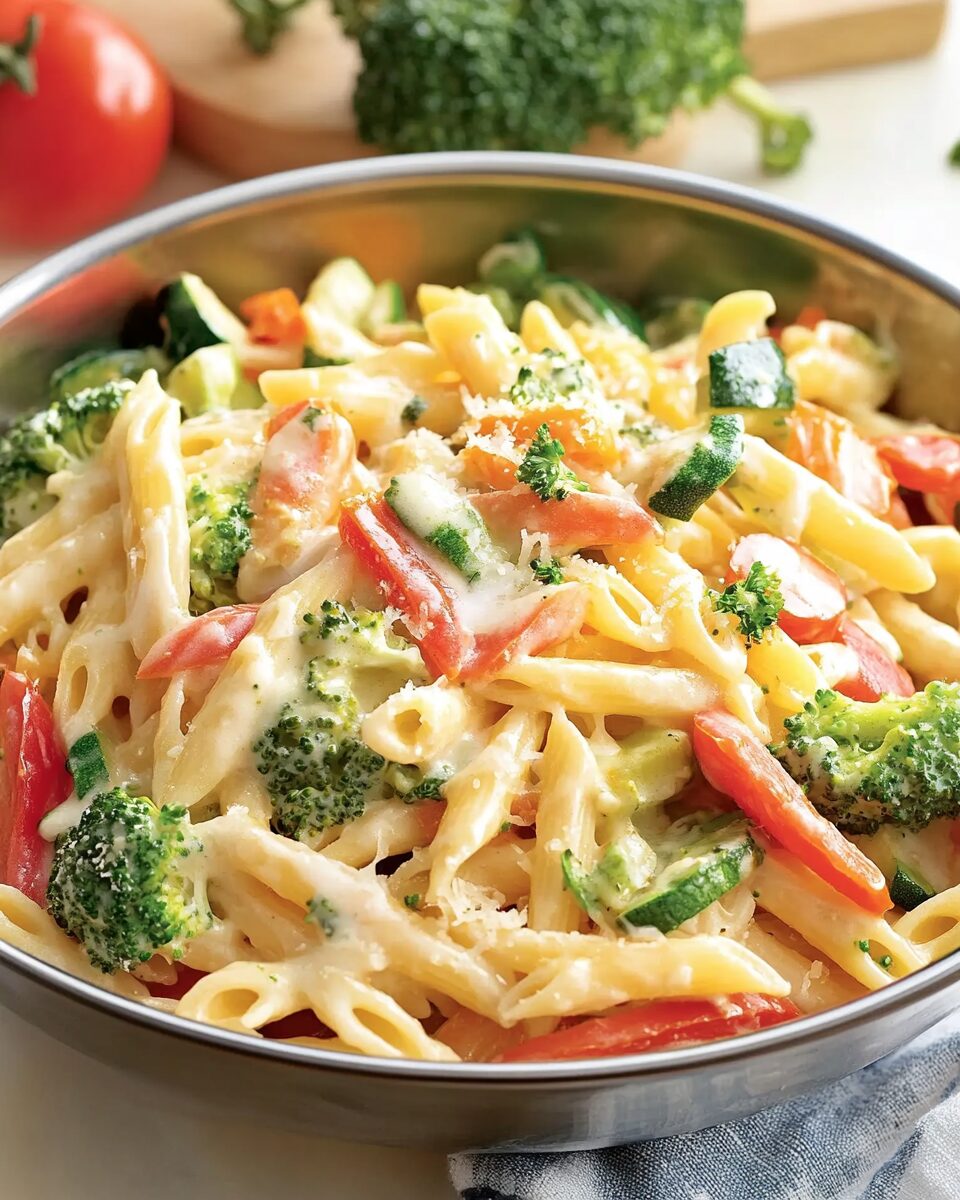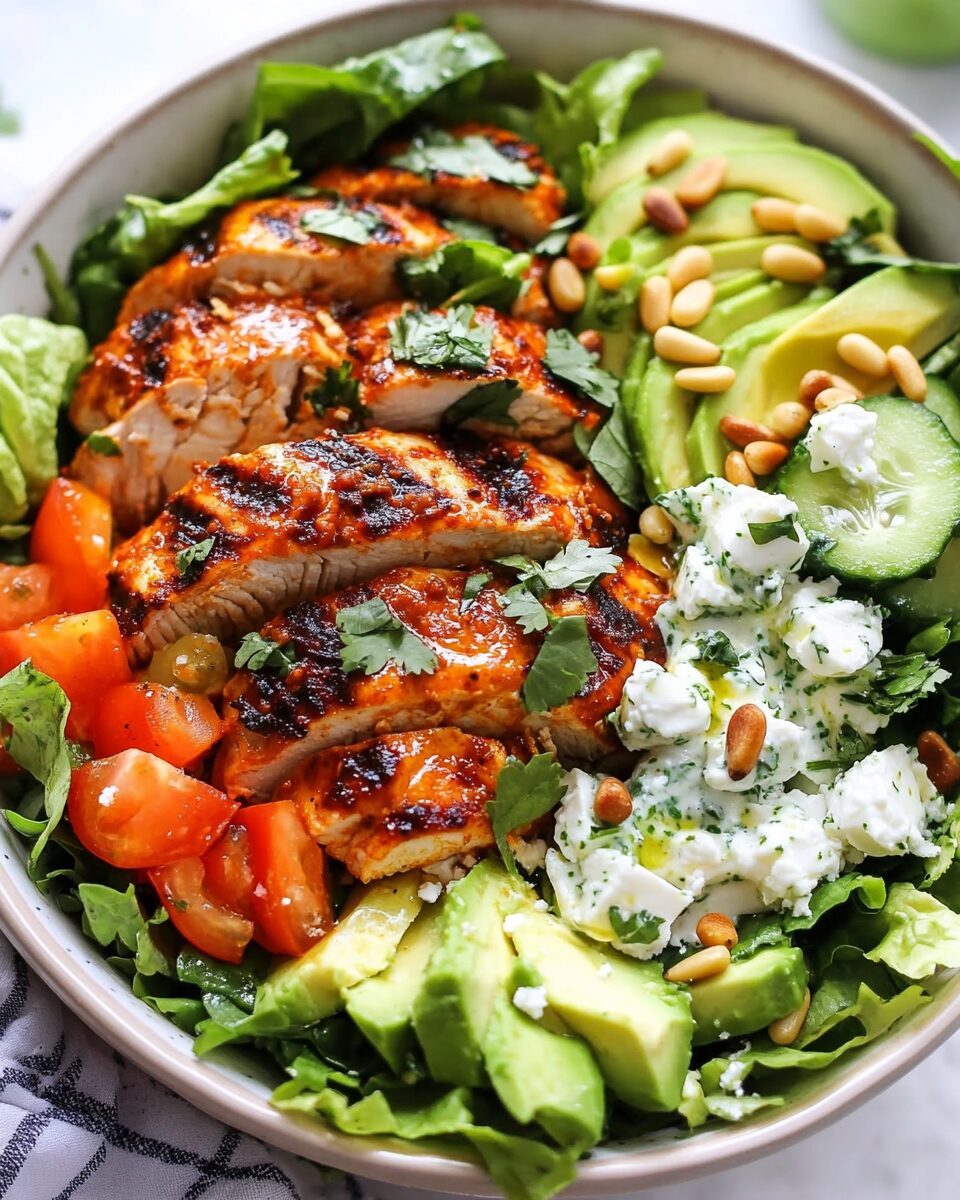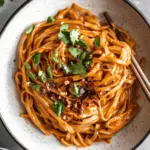Pasta Primavera is a vibrant, creamy pasta dish brimming with fresh vegetables and tossed in a light Parmesan herb sauce. This restaurant-quality meal offers a satisfying way to enjoy a medley of colorful veggies like broccoli, peppers, zucchini, carrots, and tomatoes—all gently simmered in a sauce made with chicken broth, half and half, and a blend of Italian seasonings. It’s a perfect spring or summer dinner that’s easy to make and endlessly customizable.
Full Recipe:
Ingredients
Sauce:
-
1¼ cups chicken broth
-
1¼ cups half and half
-
½ chicken bouillon cube
-
1 tsp soy sauce
-
1 tsp hot sauce (like Frank’s, optional for flavor)
-
¾ tsp each: dried parsley, basil, oregano, mustard powder
-
Pinch red pepper flakes
Vegetables & Pasta:
-
2 tbsp olive oil
-
2 cups broccoli florets
-
½ cup carrots, julienned
-
½ cup red onion, sliced
-
1 cup red bell pepper, sliced
-
½ zucchini (about 1½ cups), chopped
-
½ cup frozen peas
-
1 cup cherry tomatoes, halved or quartered
-
Salt and pepper, to taste
-
3 tbsp butter
-
3 cloves garlic, minced
-
3 tbsp flour
-
1 cup freshly grated Parmesan cheese
-
½ lb ziti (or pasta of choice)
-
2 tbsp lemon juice
Directions
Prep Sauce
Mix all sauce ingredients in a large measuring cup with a spout. Set aside.
Cook Pasta
Boil a pot of water, salt it, and cook the ziti until al dente. Drain and set aside.
Sauté Vegetables
In a large skillet over medium-high heat, heat olive oil. Add broccoli, carrots, onion, and bell pepper. Sauté 3 minutes.
Add zucchini, peas, and tomatoes. Season with salt and pepper. Cook another 2–3 minutes. Remove vegetables and set aside.
Make the Sauce
In the same skillet, melt butter and add garlic. Stir in flour and cook 2 minutes.
Gradually add the prepared sauce mixture in splashes, stirring constantly. Bring to a boil, then reduce to a simmer.
Finish and Combine
Lower the heat and stir in Parmesan cheese and lemon juice.
Add cooked pasta and toss to coat. Return vegetables to the skillet, combine, and heat through.
Serve hot with cracked black pepper and lemon slices.
Nutrients
-
Calories: 433
-
Carbohydrates: 46g
-
Protein: 15g
-
Fat: 22g (Saturated: 11g)
-
Fiber: 4g
-
Sugar: 8g
-
Sodium: 729mg
-
Cholesterol: 48mg
-
Vitamin A: 3500 IU
-
Vitamin C: 77mg
-
Calcium: 248mg
-
Iron: 2mg
The Meaning of “Primavera”
“Primavera” means “spring” in Italian, and this dish lives up to its name with a bright, garden-fresh appeal. Although the term is often associated with Italian cuisine, Pasta Primavera was actually created in North America in the late 1970s. Despite its roots, it draws from Mediterranean simplicity and flavor, combining just a few quality ingredients to create something memorable.
It quickly rose to popularity in upscale restaurants before becoming a household favorite. Today, it’s celebrated as a go-to recipe for showcasing seasonal produce, whether it’s served at a family table or an elegant dinner party.
Why You’ll Love This Dish
Pasta Primavera is an ideal meal for many reasons. It’s versatile, quick to prepare, and can be customized based on what vegetables are in season or in your fridge. The creamy Parmesan herb sauce elevates the dish, making it feel luxurious without the use of heavy cream. The addition of lemon juice brightens the flavors, while the garlic, soy sauce, mustard powder, and a hint of hot sauce contribute to a well-rounded, layered taste.
This dish also appeals to a wide range of dietary preferences. It’s naturally vegetarian-friendly if made with vegetable broth instead of chicken broth, and it can be easily adapted to dairy-free or gluten-free versions. Whether you’re looking for a healthy dinner, a crowd-pleasing entrée, or a side for grilled meat or fish, Pasta Primavera is a reliable, delicious choice.
Flavor and Texture Profile
What sets Pasta Primavera apart is the interplay of textures and flavors. The pasta provides a hearty base, while the vegetables bring variety in bite—tender broccoli, crisp bell peppers, juicy cherry tomatoes, and the slightly sweet, earthy notes of zucchini and carrots. Each vegetable contributes its unique texture, creating a satisfying contrast with every forkful.
The sauce is creamy, but light. Parmesan gives it a nutty depth, the broth adds umami, and the blend of dried herbs and mustard powder provides savory aromatics. The pinch of red pepper flakes and optional hot sauce add just a whisper of heat, making the flavor profile dynamic without overwhelming the palate.
Ingredient Flexibility and Substitutions
This is one of those recipes that embraces adaptability. Some ideas include:
-
Pasta alternatives: Use penne, farfalle, spaghetti, or even whole-wheat or gluten-free varieties.
-
Protein additions: Add grilled chicken, shrimp, or crispy chickpeas for extra protein.
-
Dairy-free: Substitute plant-based milk and Parmesan alternatives for a vegan version.
-
Vegetable swaps: Try asparagus, mushrooms, snap peas, or kale depending on the season.
-
Broth base: Use vegetable broth for a vegetarian dish or bone broth for extra richness.
The sauce is designed to be flexible, allowing you to adjust the intensity of the herbs, spices, or creamy components depending on your mood or ingredients on hand.
Health and Nutritional Benefits
Despite its rich, creamy taste, Pasta Primavera offers a variety of health benefits:
-
High in fiber from the vegetables, aiding digestion and promoting fullness.
-
Loaded with vitamins such as vitamin C from bell peppers and tomatoes, and vitamin A from carrots.
-
Good source of calcium thanks to the Parmesan and half and half.
-
Lower in saturated fat compared to traditional cream sauces due to the use of half and half.
-
Balanced macros with moderate carbs, protein from the cheese and milk, and healthy fats from olive oil.
This makes it an ideal dish for those seeking a hearty meal that doesn’t feel heavy or overly indulgent. It’s especially great for those transitioning into more plant-based eating without sacrificing flavor or satisfaction.
Perfect for Every Occasion
Pasta Primavera is incredibly versatile in terms of when and how it can be served:
-
Weeknight dinner: Quick to prep and cook in under 40 minutes.
-
Lunch leftovers: Tastes just as good reheated the next day.
-
Meal prep: Keeps well in the fridge and can be frozen for future meals.
-
Impressive entrée: Serve it at a dinner party or spring brunch with garlic bread and wine.
-
Holiday side dish: Works wonderfully alongside roasted meats or seafood.
Its vibrant appearance and comforting taste make it a favorite at potlucks, picnics, and special family occasions.
Tips for Best Results
To make sure your Pasta Primavera turns out perfectly:
-
Cook the pasta al dente so it doesn’t become mushy when mixed with the sauce and vegetables.
-
Don’t overcook the vegetables—sauté just until tender-crisp to preserve their flavor and color.
-
Use freshly grated Parmesan for the best melt and flavor.
-
Layer the seasoning gradually—taste the sauce as it simmers and adjust salt and spice accordingly.
-
Serve immediately once combined to enjoy the full flavor and freshness of the vegetables.
Origins and Cultural Appeal
While Pasta Primavera is widely associated with Italian cuisine, its creation is credited to Sirio Maccioni of Le Cirque restaurant in New York City in the late 1970s. Originally conceived as a lighter, vegetable-forward pasta option during a culinary trip to Canada, the dish quickly became a sensation. Its success sparked a movement toward incorporating more vegetables into main dishes, especially in upscale American restaurants.
It represents a fusion of Italian techniques with American innovation, making it a modern classic that remains relevant decades after its invention.
Why It’s a Recipe Worth Repeating
Pasta Primavera is one of those rare dishes that’s both comforting and refreshing. It’s as pleasing to look at as it is to eat, and the combination of textures, flavors, and nutrients makes it a feel-good meal you’ll want to revisit throughout the year. Whether you’re cooking to impress or just want something satisfying for yourself, this recipe checks all the boxes.
It’s also a perfect starting point for culinary creativity—switch up the herbs, add a splash of cream or white wine, try it with gnocchi, or toss in some roasted garlic. The foundation is strong, so every variation will feel like a delicious discovery.
Conclusion
Pasta Primavera is more than just a creamy pasta with vegetables—it’s a celebration of fresh produce, vibrant flavors, and culinary creativity. Light yet satisfying, this dish brings together the heartiness of pasta with the goodness of colorful vegetables and a creamy herb sauce that elevates every ingredient. Whether you stick to the classic or add your own twist, this recipe promises to deliver on flavor, nourishment, and visual appeal. Easy to prepare and endlessly customizable, it’s a must-have in every cook’s recipe collection.








